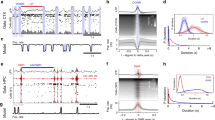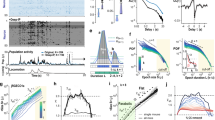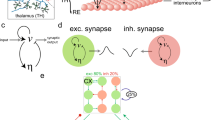Abstract
Intracellular recordings from reticular thalamic (RE) neurons in vivo revealed inhibitory postsynaptic potentials (IPSPs) between RE cells that reversed and became depolarizing at the hyperpolarized membrane potentials that occur during sleep. These excitatory IPSPs can directly trigger low–threshold spikes (LTSs). The oscillatory mechanisms underlying IPSP–triggered LTSs crowned by spike bursts were investigated in models of isolated RE networks. In a one–dimensional network model, external stimulation evoked waves of excitation propagating at a constant velocity of 25–150 cells per second. In a large–scale, two–dimensional model of the reticular nucleus, the network showed transient or self–sustained oscillations controlled by the maximum conductance of the low–threshold calcium current and the membrane potential. This model predicts that the isolated reticular nucleus could initiate sequences of spindle oscillations in thalamocortical networks in vivo.
This is a preview of subscription content, access via your institution
Access options
Subscribe to this journal
Receive 12 print issues and online access
$209.00 per year
only $17.42 per issue
Buy this article
- Purchase on Springer Link
- Instant access to full article PDF
Prices may be subject to local taxes which are calculated during checkout








Similar content being viewed by others
References
Steriade, M., Deschênes, M., Domich, L. & Mulle, C. Abolition of spindle oscillations in thalamic neurons disconnected from nucleus reticularis thalami. J. Neurophysiol. 54, 1473–1497 (1985).
Steriade, M. & Llinás, R. R. The functional states of the thalamus and the associated neuronal interplay. Physiol. Rev. 68, 649–742 ( 1988).
Steriade, M., Jones, E. G. & Llinás, R. R. Thalamic Oscillations and Signaling (Wiley, New York, 1990).
von Krosigk, M., Bal, T. & McCormick, D. A. Cellular mechanisms of a synchronized oscillation in the thalamus. Science 261, 361– 364 (1993).
Steriade, M., McCormick, D. A. & Sejnowski, T. J. Thalamocortical oscillations in the sleeping and aroused brain. Science 262, 679– 685 (1993).
Bal, T. & McCormick, D. A. What stops synchronized thalamocortical oscillations? Neuron 17, 297– 308 (1996).
Budde, T., Biella, G., Munsch, T. & Pape, H. C. Lack of regulation by intracellular Ca2+ of the hyperpolarization–activated cation current in rat thalamic neurones. J. Physiol. (Lond.) 503, 79–85 (1997).
Lüthi, A., Bal, B. & McCormick, D. A. Periodicity of thalamic spindle waves is abolished by ZD7288, a blocker of Ih. J. Neurophysiol. 79, 3284–3289 (1998).
Steriade, M., Domich, L., Oakson, G. & Deschênes, M. The deafferented reticular thalamic nucleus generates spindle rhythmicity. J. Neurophysiol. 57, 260–273 ( 1987).
Golomb, D., Wang, X. J. & Rinzel, J. Synchronization properties of spindle oscillations in a thalamic reticular nucleus model. J. Neurophysiol. 72, 1109–1126 (1994).
Destexhe, A., Contreras, D., Sejnowski, T. J. & Steriade, M. A model of spindle rhythmicity in the isolated thalamic reticular nucleus. J. Neurophysiol. 72, 803– 818 (1994).
Ulrich, D. & Huguenard, J. R. Nucleus–specific chloride homeostasis in rat thalamus. J. Neurosci. 17, 2348–2354 (1997).
Ulrich, D. & Huguenard, J. R. γ–Aminobutyric acid type B receptor–dependent burst–firing in thalamic neurons: A dynamic clamp study. Proc. Natl. Acad. Sci. USA 93 , 13245–13249 (1996).
Contreras, D., Curró Dossi, R. & Steriade, M. Electrophysiological properties of cat reticular thalamic neurones in vivo. J. Physiol. (Lond.) 470, 273–294 (1993).
Domich, L., Oakson, G. & Steriade, M. Thalamic burst patterns in the naturally sleeping cat: a comparison between cortically projecting and reticularis neurones. J. Physiol. (Lond.) 379, 429–449 (1986).
Contreras, D. & Steriade, M. Cellular basis of EEG slow rhythms: a study of dynamic corticothalamic relationships. J. Neurosci. 15, 604–622 ( 1995).
Destexhe, A., Contreras, D., Steriade, M., Sejnowski, T. J. & Huguenard, J. R. In vivo, in vitro, and computational analysis of dendritic calcium currents in thalamic reticular neurons. J. Neurosci. 16, 169–185, (1996).
Contreras, D., Timofeev, I. & Steriade, M. Mechanisms of long–lasting hyperpolarizations underlying slow sleep oscillations in cat corticothalamic networks. J. Physiol. (Lond.) 494, 251–264 (1996).
Steriade, M., Jones, E. G. & McCormick, D. A. Thalamus: Organization and Function (Elsevier, Oxford, 1997).
Timofeev, I. & Steriade, M. Low–frequency rhythms in the thalamus of intact–cortex and decorticated cats. J. Neurophysiol. 76, 4152–4168 ( 1996).
Ulrich, D. & Huguenard, J. R. GABAA–receptor–mediated rebound burst firing and burst shunting in thalamus. J. Neurophysiol. 78, 1748–1751 ( 1997).
Timofeev, I. & Steriade, M. Cellular mechanisms underlying intrathalamic augmenting responses of reticular and relay neurons. J. Neurophysiol. 79, 2716–2729 (1998).
Bazhenov, M., Timofeev, I., Steriade, M. & Sejnowski, T. J. Cellular and network models for intrathalamic augmenting responses during 10 Hz stimulation. J. Neurophysiol. 79, 2730–2748 (1998).
Golomb, D. & Amitai, Y. Propagating neuronal discharges in neocortical slices: Computational and experimental study. J. Neurophysiol. 78, 1199–1211 ( 1997).
Golomb, D. Models of neuronal transient synchrony during propagation of activity through neocortical circuitry. J. Neurophysiol. 79, 1–12 (1998).
Rinzel, J., Termal, D., Wang, X. J. & Ermentrout, B. Propagating activity patterns in large–scale inhibitory neuronal networks. Science 279, 1351–1355 ( 1998).
Traub, R. D., Miles, R. & Jefferys, J. G. R. Synaptic and intrinsic conductances shape picrotoxin–induced synchronized after–discharges in the guinea–pig hippocampal slice. J. Physiol. (Lond.) 461, 525– 547 (1993).
Traub, R. D., Miles, R. & Jefferys, J. G. R. Analysis of the propagation of disinhibition–induced after–discharges along the guinea–pig hippocampal slice in vitro. J. Physiol. (Lond.) 472, 267– 287 (1993).
Kuramoto, Y. Chemical Oscillations, Waves, and Turbulence (Springer–Verlag, Berlin, 1984).
Coullet, P., Gil, L. & Lega, J. Defect–mediated turbulence. Phys. Rev. Lett. 62, 1619–1622 (1989).
Bazhenov, M. & Rabinovich, M. Synchronized disorder in a 2D complex Ginzburg–Landau equation. Physica D 73 , 318–334 (1994).
Winfree, A. When Time Breaks Down (Springer, New York, 1987).
Michelson, H. B. & Wong, R. K. S. Excitatory synaptic responses mediated by GABAA receptors in the hippocampus. Science 253, 1420–1423 (1991).
Michelson, H. B. & Wong, R. K. S. Synchronization of inhibitory neurones in the guinea–pig hippocampus in vitro. J. Physiol. (Lond.) 477, 35–45 (1994).
Staley, K. J., Soldo, B. L. & Proctor, W. R. Ionic mechanisms of neuronal excitation by inhibitory GABAA receptors. Science 269, 977–981 (1995).
Nicoll, R. A., Malenka, R. C. & Kauer, J. A. Functional comparison of neurotransmitter receptor subtypes in mammalian central nervous system. Physiol. Rev. 70, 513–565 (1990).
Qian, N. & Sejnowski, T. J. When is an inhibitory synapse effective. Proc. Natl. Acad. Sci. USA 87, 8145–8149 (1990).
Destexhe, A., Bal, T., McCormick, D. A. & Sejnowski, T. J. Ionic mechanisms underlying synchronized oscillations and propagating waves in a model of ferret thalamic slices. J. Neurophysiol. 76, 2049–2070 (1996).
Traub, R. D. & Miles, R. Neuronal Networks of the Hippocampus (Cambridge, Cambridge Univ. Press, 1991).
Huguenard, J. R. & Prince, D. A. A novel T–type current underlies prolonged Ca2+–dependent burst firing in GABAergic neurons of rat thalamic reticular nucleus. J. Neurosci. 12, 3804–3817 ( 1992).
Huguenard, J. R. & McCormick, D. A. Simulation of the currents involved in rhythmic oscillations in thalamic relay neurons. J. Neurophysiol. 68, 1373– 1383 (1992).
Destexhe, A., Mainen, Z. F. & Sejnowski, T. J. Synthesis of models for excitable membranes, synaptic transmission and neuromodulation using a common kinetic formalism. J. Comp. Neurosci. 1, 195–230 (1994).
Zhang, S. J., Huguenard, J. R. & Prince, D. A. GABAA receptor–mediated Cl– currents in rat thalamus reticular and relay neurons. J. Neurophysiol. 78, 2280–2286 (1997).
Acknowledgements
This research was supported by the Howard Hughes Medical Institute, the Sloan Center for Theoretical Neurobiology, the Human Frontier Science Program and the Medical Research Council of Canada.
Author information
Authors and Affiliations
Corresponding author
Rights and permissions
About this article
Cite this article
Bazhenov, M., Timofeev, I., Steriade, M. et al. Self–sustained rhythmic activity in the thalamic reticular nucleus mediated by depolarizing GABAA receptor potentials. Nat Neurosci 2, 168–174 (1999). https://doi.org/10.1038/5729
Received:
Accepted:
Issue Date:
DOI: https://doi.org/10.1038/5729
This article is cited by
-
Multimodal pathophysiological dataset of gradual cerebral ischemia in a cohort of juvenile pigs
Scientific Data (2021)
-
Microstimulation-induced inhibition of thalamic reticular nucleus in non-human primates
Experimental Brain Research (2019)
-
Differential regulation of chloride homeostasis and GABAergic transmission in the thalamus
Scientific Reports (2018)
-
Spatiotemporal dynamics in excitable homogeneous random networks composed of periodically self-sustained oscillation
Scientific Reports (2017)
-
Linking dynamics of the inhibitory network to the input structure
Journal of Computational Neuroscience (2016)



